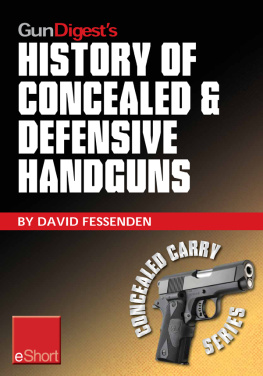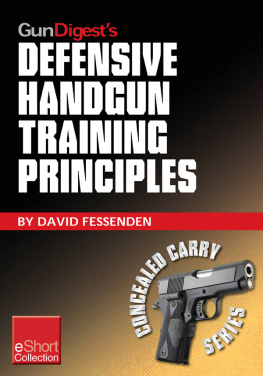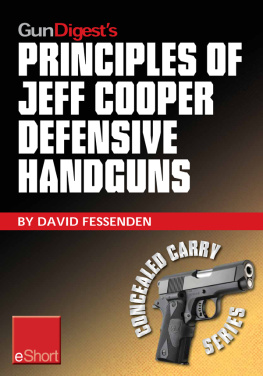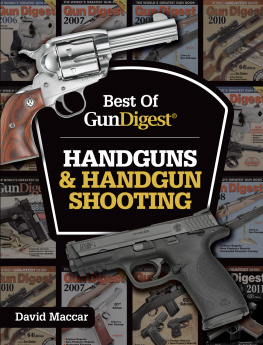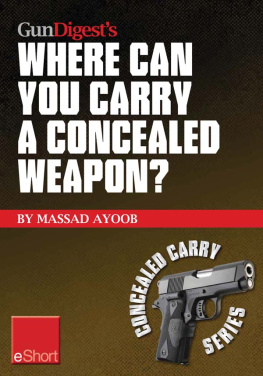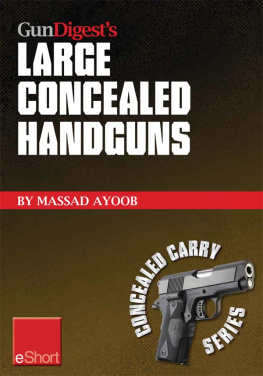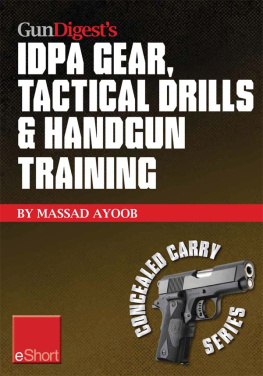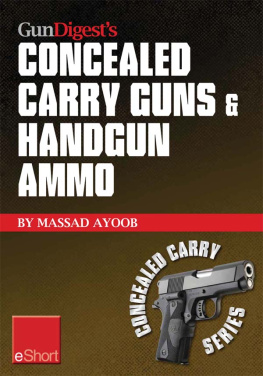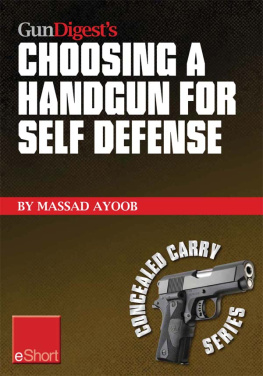David Fessenden - Gun Digests History of Concealed & Defensive Handguns eShort
Here you can read online David Fessenden - Gun Digests History of Concealed & Defensive Handguns eShort full text of the book (entire story) in english for free. Download pdf and epub, get meaning, cover and reviews about this ebook. year: 2012, publisher: F+W Media, genre: Home and family. Description of the work, (preface) as well as reviews are available. Best literature library LitArk.com created for fans of good reading and offers a wide selection of genres:
Romance novel
Science fiction
Adventure
Detective
Science
History
Home and family
Prose
Art
Politics
Computer
Non-fiction
Religion
Business
Children
Humor
Choose a favorite category and find really read worthwhile books. Enjoy immersion in the world of imagination, feel the emotions of the characters or learn something new for yourself, make an fascinating discovery.
- Book:Gun Digests History of Concealed & Defensive Handguns eShort
- Author:
- Publisher:F+W Media
- Genre:
- Year:2012
- Rating:3 / 5
- Favourites:Add to favourites
- Your mark:
- 60
- 1
- 2
- 3
- 4
- 5
Gun Digests History of Concealed & Defensive Handguns eShort: summary, description and annotation
We offer to read an annotation, description, summary or preface (depends on what the author of the book "Gun Digests History of Concealed & Defensive Handguns eShort" wrote himself). If you haven't found the necessary information about the book — write in the comments, we will try to find it.
In this excerpt from Defensive Handgun Skills, David Fessenden gives a basic and very useful look at the history of defensive handgun doctrine. Understanding the past will enable you to be better prepared today.
Gun Digests History of Concealed & Defensive Handguns eShort — read online for free the complete book (whole text) full work
Below is the text of the book, divided by pages. System saving the place of the last page read, allows you to conveniently read the book "Gun Digests History of Concealed & Defensive Handguns eShort" online for free, without having to search again every time where you left off. Put a bookmark, and you can go to the page where you finished reading at any time.
Font size:
Interval:
Bookmark:


As most of us know, there have been primitive firearms around since the mid-1300s. Of course, over the centuries, they evolved into the sophisticated weapons systems that we can see on the battlefields and in the hunting, recreational and sporting venues spread around the world. So how did the theory and principles of defensive hand gunning emerge? Good question.
For the answer, we need to look back to World War II and to Lt. Col. Jeff Cooper and the evolution of his fast draw and combat shoots that were staged at Big Bear Lake, California, in the 1950s. Up until that time, handgun shooting consisted of one-handed target shooting with none of the run-and-gun tactics that we see employed today at many of the IPSC and IDPA venues. This concept would change considerably under the guidance of Col. Cooper and his Big Bear contests in the next decade.
In fact, I was serving in the Marine Corps during this time and learned to shoot my 1911A1 duty pistol in this old time Camp Perry-style, one-handed technique with the firing side arm horizontal, locked out, and my body perpendicular to the target. It was often referred to as the dueling position. Coopers Big Bear shoots, by their very nature, were spawning grounds for experimentation and innovation as each competitor worked to get a competitive edge over his fellow competitors.
Initially, they used revolvers as their weapon of choice. Cooper started shooting his 1911A1 Colt Commander, which he had trained with while an officer in the Marine Corps. As his tournament wins grew in number, more and more of his fellow competitors took note and switched to various semiautomatics, mainly 1911-type weapons. Even Thell Reed, the King of the Single Actions, eventually switched to the 1911A1. All experimented with movement and combat (tactical) applications with this handgun.

One such innovator was L.A. County Sheriffs Deputy Jack Weaver. He worked on several stances and grips over time and figured out that a more stable and aggressive two-handed grip would afford him the accuracy, speed and precision he needed. At first he aimed his weapon at the target in a semi-point-shoot method. To improve his consistency and precision during the shoots, Weaver experimented with raising the weapon higher to eye level for precision-aimed shots. His accuracy and winning percentages improved immediately. Thus was born the Weaver Stance and Grip. (I discuss the Weaver Stance and Grip in great detail later in this book.) It consists of a 30 bladed stance with the firing-side foot pulled back about four to six inches from the firing line and combined with an overlapping two-handed grip.
The Weaver Stance and Grip proved to be a winner. It assisted in managing recoil and allowed Weaver to deliver rapid-fire multiple shots with considerable accuracy. Soon, his fellow shooters adopted this shooting position and today the Weaver is universally used by all shooters in the field of defensive guncraft. (Jack Weaver passed away in Carson City, Nevada, in July of 2009.)
Coopers shooting tournaments were initially called Leather Slaps and were essentially blank-firing fast-draw contests. They became very popular with the viewing public, but soon evolved into true combat-style action shoots, combining movement with time limitations. Cooper held them exclusively at the newly-opened ski resort atop Tejon Pass, in San Bernardino county, California. He called his group the Bear Valley Gunslingers. (This ski resort is still there today and is now called Snow Summit.)
As the popularity of Coopers contests spread, the two-handed Weaver stance and grip were being emulated by the shooting public all over the southwest. The name of Coopers organization had now become the South West Combat Pistol League. New shooting clubs formed teams to participate in this new and exciting form of pistol competition.
It is at this point that Cooper began to form the nucleus of what was to become his Modern Technique of the Pistol. It contained the basic elements of his form of modern pistol shooting and its combat nature, compared to the older Camp Perry style of static competitive and recreational shooting of the past. The Big Bear shoots gave impetus and seed to combat shooting for the public at large and many big-name shooters rushed to join Cooper and compete in them: Bob Munden, Ray Chapman, Eldon Carl, Thell Reed, John Shaw, Mickey Fowler, Mike Dalton and Armend Swenson, to name just a few.

As the popularity of this sport grew, spurred on by the many TV westerns, some of the fledging anti-gun groups of the day petitioned the California Secretary of States office to change the name of the SWCPL. They objected to the use of the word combat in the name. The California legislature caved in to the offended group and informed Cooper that the name had to be changed. Cooper acquiesced and renamed his club the International Practical Shooters Confederation. Thus was born what we now refer to as IPSC!
With IPSC established and a bad taste in his mouth for California and its brand of politics, Cooper left the IPSC management group and took his combat shooting and movement tactics and moved to Arizona. There, Cooper started his American Pistol Institute (API), in Paulden, Arizona. He later changed the name to Gunsite Firearms Training Center. He devoted himself to training both civilians and law enforcement personnel in the techniques of personal protection that were formulated during his Big Bear shooting days. At Gunsite, he instituted his Modern Techniques of the Pistol into the curriculum of his defensive handgun classes. Now civilians and law enforcement students were being taught the techniques that proved so successful during the competition that Cooper and his pals conducted at Big Bear Lake. His classes covered all the principles of movement, aggressiveness, tactics, mindset, the Weaver stance, gun handling, marksmanship and pistol deployment, coupled with his thoughts on speed, precision and accuracy. This, folks, is the precursor to what we now call defensive guncraft and its correlation to personal protection with a handgun. We have Col. Cooper and his sharp mind and wit to thank for his contribution to our welfare.
Gunsite is today rated as one of the top firearms training facilities in the country, along with Front Sight, Thunder Ranch and LFI. Cooper spent his remaining years writing, lecturing, consulting and operating and teaching at Gunsite. Through a couple of ownership changes, Cooper stayed at Gunsite until his health began to fail and he finally passed away on the September 26, 2006, at his home, the Sconce, on the Gunsite property.
The passage of the first CCW law in the country in 1987, in Florida, gave further impetus to the need for professional training in the art of defensive handgun skills. History has borne this out in recent years a veritable boom in gun ownership has occurred, along with the growth of firearms training facilities. Not coincidentally, numerous peer-researched surveys all show an overall reduction in violent gun-related crime across our country. All this has served to enhance the reputation of Col. Jeff Cooper as the genius who was responsible for the development of the principles of defensive handgun skills.
Font size:
Interval:
Bookmark:
Similar books «Gun Digests History of Concealed & Defensive Handguns eShort»
Look at similar books to Gun Digests History of Concealed & Defensive Handguns eShort. We have selected literature similar in name and meaning in the hope of providing readers with more options to find new, interesting, not yet read works.
Discussion, reviews of the book Gun Digests History of Concealed & Defensive Handguns eShort and just readers' own opinions. Leave your comments, write what you think about the work, its meaning or the main characters. Specify what exactly you liked and what you didn't like, and why you think so.

